Indigenous Chicken
Introduction
Indigenous chicken are an important sub-sector of the livestock sector and constitutes 70 % of the chicken population in Kenya. They provide the much-needed high-value protein and income for rural household
KARI Improved Chicken (KC)
- A dual-purpose bird with improved production for both meat and eggs.
- The breed has characteristics of indigenous chicken but with higher egg and meat production.
- Adapts to various climatic conditions and can be kept all over Kenya
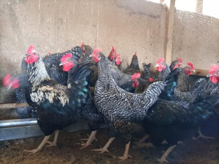
KC1 and KC2
- High growth rate and age at first egg - 4.5 months.
- Produce 200-230 eggs per bird.
- Egg size 50-60 g.
- Faster weight gain, High quality meat with better muscle structure.
- Age at 2 kg for cocks - 4 months.
- More indigenous, hence the bird can scavenge for part of its feed efficiently.
- Less than 10% will go broody.
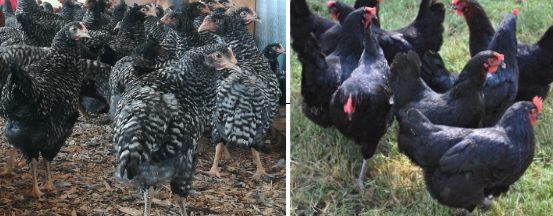
Basic requirements for poultry housing:
- Stocking density of four birds per square meter
- Building with open sides is ideal for proper airflow.
- East to west orientation
- Open in a direction that allows wind to blow across the width of the building.
- Buildings relying on natural airflow for ventilation should not exceed 8 m in width
- Birds do best where there is plenty of natural light that does not raise the temperature of the house, hence East-west orientation the house is key to avoid direct sunlight.
- Protection from weather and predators.
- Coops or baskets may be used to house mother hens and chicks in order to reduce chick mortality due to predators, thieves and rain.
Semi range housing for Indigenous chicken
Appropriate housing design, construction and management is key in chicken production. A chicken house with the following specifications:
- Stocking density: 100 layers
- Iron sheets: 5 m x 3 m x 30 G
- Floor-made of wire mesh
- Sides made of chicken wire
- House floor raised
- Feeder is made of galvanized flat iron sheets (8” x 4”) and timber Smoothened round stick handle that spins to discourage bird parching (31 ft long) Improved feeder which minimizes chicken feed wastage
- The feed trough is easy to fabricate and can be used for a longer duration.
- Black soldier flies are environment friendly insects whose larvae is used as an alternative feed and source of high quality protein for livestock.
- 100 g of eggs can produce 520 kg of BSF larvae within 14 days.
- When incorporated into feeds it can reduce the cost of production and enhance growth rate, resulting with increased productivity.
Evaluate new feed additive technologies
- Feed additives will improve utilization of nutrients to produce poultry products.
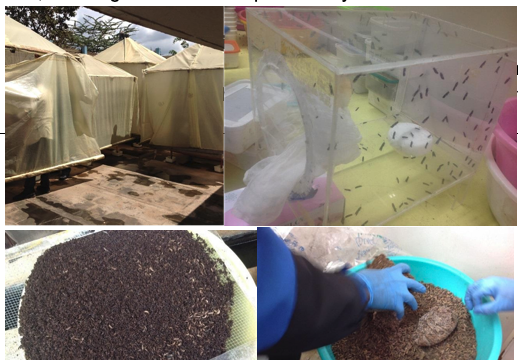
- Improved gut health, hence enhanced feed utilization to enhance feed and energy utilization.
- Food and feed safety products like mycotoxin binders will degrade non-starch polysaccharides (NSPs) in crop byproducts.
Note: The improved indigenous chicken are high producing and will benefit from these technologies, however, they have not been tested in the Kenya.
Feed formulations
Each stage, in the growth of chicken, has different feed nutritional requirements. Therefore, using locally available ingredients, the farmer can make feeds using this guide:
Home-made rations for different classes of birds using locally available ingredients.
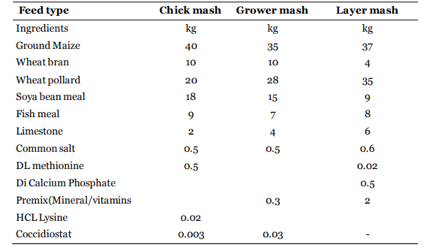
Improved biosecurity practices on poultry farms, food and feed safety
- Biosecurity measures on the farm help reduce the risk of zoonotic diseases, like Salmonellosis, mycoplasmosis, Campylobacter and E. coli spp.
- Transmitted by inhalation of dried droppings, secretions and feather dust of infected birds.
- Maintenance of hygiene improves productivity of indigenous chicken.
Manure management
Integrated poultry manure management for crop and dairy production
- Add chicken manure to the soil for soil health/fertility and increased crop productivity
- Recycling the nutrients in manure reduces the need for additional fertilizer purchase.
- Poultry manure can be used as a protein source in dairy cattle production.
- Manure plays an essential role in the nutrient cycle where crops grow on land to feed livestock, which in return feeds the land with their manure.
Improved hatching management practice

Photo by; homerange
- Proper feeding and health of laying hens to enhance quality of hatching eggs and higher hatchability
- Selection and storage of hatching eggs
Candling to determine if the eggs are fertile and should be at 7 and 18 days (early and late embryo development stages and detection of meat spots). Use the meat spot to cull birds that produce this type of eggs as it is passed on to her progeny
Hay box brooder
- Limitation of power in rural areas present a challenge in chick brooding.
- Smallholder farmers incur great losses of chicks due to predation.
- The hay box brooder provides shelter for chicks against predators during the day and warmth during the night
- Simple fabrication of timber, hay and wire mesh.
- Available in different dimensions based on number of chicks
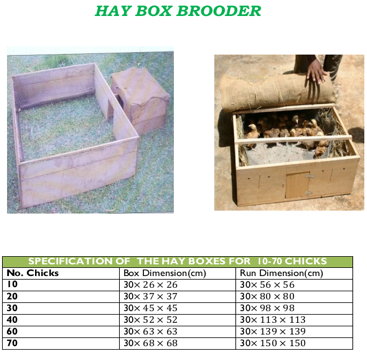
Disease Control: Gumboro disease control in chicken for increased food and nutrition security
- Gumboro vaccine recommendations based on virus typing (hot, intermediate or mild).
Prevention (Vaccination): Thermostable New Castle Disease vaccines.
Newcastle disease is a major constraint to indigenous chicken productivity and often causes 80-100% mortality in unvaccinated flocks, hence a vaccine (The I-2 vaccine) suitable for the Kenyan indigenous chicken production system.
- The I-2 ND vaccine can retain its protective ability for 8 weeks at 28°C when in freeze-dried form and stored in the dark ( thermostable)
- This vaccine provides 62% protection against Newcastle disease virus in chicken under a free ranging system and over 96 % protection under a confined system.
- It can be administered via eye or nose drop, oral drench, or drinking water; mixed with certain feeds or by injection
- Its ease of administration makes it suitable for use by farmers;
- The vaccine strain can be transmitted by contact from vaccinated to non-vaccinated birds
It can be safely administered to chickens of any age from day-old to adult
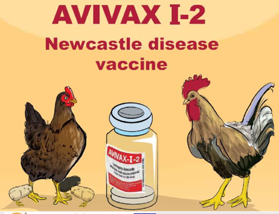
Vaccination schedule in rearing KARI improved indigenous chicken(How to);
|
AGE |
VACCINE |
MODE OF ADMINISTRATION |
|
Day 1 |
Mareks |
Subcutaneous |
|
Day 10 |
1st Infectious Bursal Disease Vaccine (IBDV) or Gumboro |
Drinking water |
|
Day 18 |
2nd Infectious Bursal Disease Vaccine (IBDV) or Gumboro |
Drinking water |
|
3 weeks |
1st Newscastle Disease Vaccine (Avivax I-2) |
Eye drop or Drinking water |
|
3 weeks (in hot areas) |
Fowl Pox Vaccine |
Wing web jab |
|
6 weeks (other areas) |
Fowl Pox Vaccine |
Wing web jab |
|
8 weeks |
2nd Newscastle Disease Vaccine (Avivax I-2) |
Eye drop or Drinking water |
|
8 weeks |
Fowl Typhoid |
Intramuscular injection |
|
18 weeks |
3rd Newscastle Disease Vaccine (Avivax I-2) |
Eye drop or Drinking water |
|
19 weeks |
De-worming |
Drinking water |
Note:
- NEVER vaccinate a sick chicken.
- Consult your veterinary/livestock for detailed vaccination programs in your area.
To build a financially successful chicken enterprise, record keeping is a must
- Collect relevant information to keep track of activities(feed and water intake), production(eggs/meat/chicks) and important events(vaccinations/treatment/curling) on a farm
- Records will also guide the veterinarians a lot when they are coming to examine your flock and help them to prescribe quick solutions for problems affecting your poultry.
Your records should include the following:
- Records of type of feeds the chicks are consuming.
- Batch number.
- Feed expiry date.
- Daily feed intake.
- Daily mortality.
- Culls
- Daily egg production.
- Vaccinations and Cost.
- Other expenses
Keep vaccination and medication records for your flock:
- Age of the poultry during vaccination/medication
- The drug or vaccine used
- Mode of drug/vaccine administration
- Batch number
Expiry date
Selection and grading of table eggs
- Select and grade eggs based on external and interior factors like weight, cracks, meat and blood spots.
- Grade/sort the eggs and carefully package them in crates.
Photo by; Chicken Check in
- A chicken is cut in parts, packed in trays and wrapped.
- Store in a freezer for longevity.
- The wrapped product is inspected again to ensure it meets both consumer and customer expectations.
- Harvest chicks from the hatchery with care.
- Administer the pre-vaccinations in and carry them in chick trays into brooding
- Selling eggs and chickens at farm-gate.
- Eggs and chicken can be sold to wholesalers.
- They can be sold directly to retailers and institutional consumers such as hotels, restaurants and hospitals.
- Branding the packaging.
- Use local advertising channels to get your eggs to the right market
- Manure can be utilized in the farm yard.
Chicken manure utilization Photo by; istockphoto
The eggs (fried/boiled) and meat are a good source of protein.

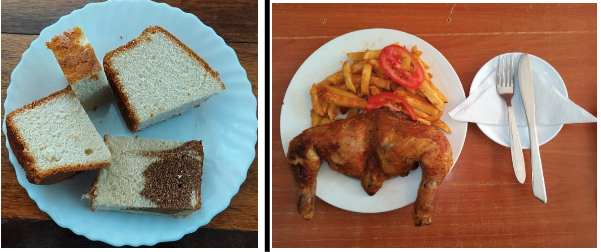
KALRO-Indigenous chicken Mobile application
- This is a mobile application that works under the android operating system.
- It has summary details on feeding, vaccination, housing, breeding and selection, economics and other general information on chicken production.
- The app will ease access to information on chicken farming and related service
KALRO-Indigenous chicken Mobile application
- KES 100 per day old chick
- KES 250 per month old chick
- KES 1000 per tray of 30 fertile eggs
- KES 1200 per breeding cock
- https://www.kalro.org/asal-aprp/docs/Brief%20on%20the%20I-2%20ND%20Vaccine_%20livelyhood%20docs.pdf
- https://www.kalro.org/sites/timps/KCSAP%20TIMPS%20-%20IC%20VC%20Aug2019.docx.pdf
- https://www.kalro.org/asal-aprp/sites/default/files/Feeding_Indigenous_Chicken.pdf
- https://www.livestocking.net/vaccination-schedule-kari-improved-kienyeji-chicken
Kenya Agricultural and Livestock Research Organization
Post Office: P.O. Box 57811, 00200, City Square, Nairobi, Kenya
Email : info@kalro.org
Location : Kaptagat Rd, Loresho, Nairobi, Kenya
Call center: 0111010100